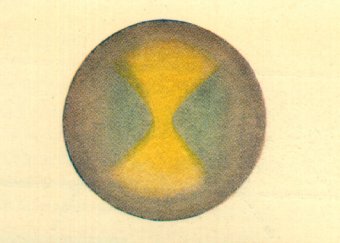- Ellen Althuizen (2001). Duizenden verwarde vogels. N&T,
Nr. 4, april, p.17.
- Theo Schildkamp (2000). Vogels reizen met acht extra zintuigen.
Gelders Dagblad 28 sep 2000, p.AP1WET, k.1-6.
Dat zijn 1. zonnekompas, 2. sterrenkompas, 3. geurkompas, 4. gezichtskompas, 5. geluidskompas, 6. luchtdrukmeter, 7. kompas op de bundels van Haidinger (zie hieronder), 8. magneetkompas.
De bundels van Haidinger - Dat zijn de gele veegjes die je ziet wanneer je lang naar de hemel staart en je hoofd heen en weer beweegt. De positie en de aard van deze kleine zinsbegoochelingen hebben direct te maken met de zonnestand. Vogels weten daar heel goed profijt van te trekken.
Haidinger's Brush - Did you know that your eye can detect the polarization of light? Haidinger's brush is figure that will appear before your eyes when viewing polarized light. The figure looks like a brownish-yellow hourglass and is shown above. Haidinger's brush is easy to see. Just take some polaroid film (or a pair of polaroid sunglasses) and look through it at a lamp about 5 to 10 feet away. A fluorescent lamp with a large flat cover is the best for this. Alternatively, you can look at a big piece of white paper that is strongly illuminated by a lamp. Rotate the film back and forth by 90 degrees. As you do this, you should be able to see a mustard colored hourglass which rotates as you rotate the film. If you keep the film stationary then the figure will fade within a few seconds. The hourglass spans about 3 degrees (which is about the angle spanned by two fingers held at arm's length). The yellow hourglass is the easiest portion of the figure to see. Many people can also see two bluish-purple dots at the side of the hourglass. My eyes need to be extremely relaxed to see these side dots - but it's worth it! The dots are a wonderful shade of purple - almost the shade of a bare fluourescent light bulb. My colleague Roger sees an aquamarine color, similar to that shown in the picture above.
M.v.g. G. Nevenzel. Overzicht van onderwerpen.